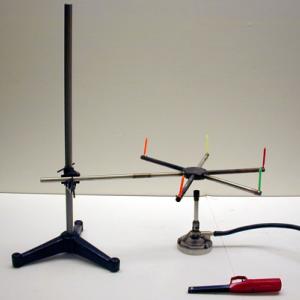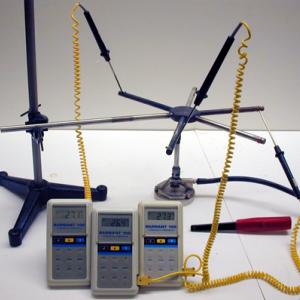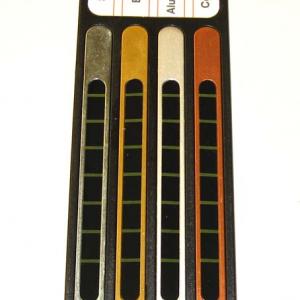College of Liberal Arts & Sciences
4B30.10 - Thermal Conductivity Demo
There are enough digital thermometers to put one on each finger or candles may be used in their place. Heat the center with a Bunsen burner and observe the different conductivities. The copper should be first followed by aluminum, brass, iron, and the stainless steel should not even be warm to the touch even after minutes of heating.
Bring some water to near boiling and dip only the ends of the four conducting bars into the water.
- Mark Kinsler and Evelyn Kinzel, "A Simple Classroom Simulation of Heat Energy Diffusing Through a Metal Bar", TPT, Vol. 45, #6, Sept. 2007, p. 382.
- Donald E. Rehfuss, "Current Concepts Consolidated", TPT, Vol. 42, #2, Feb. 2004, p. 103.
- Mary Ann White, Vladimir Murashov, and Paul Bessonette, "Thermal Conductivity of Food-Thawing Trays", TPT, Vol. 34, #1, Jan. 1996, p. 4.
- Craig F. Bohren, "Kitchen Physics", TPT, Vol. 33, #6, Sept. 1995, p. 326.
- Philip B. Allen, "Conduction of Heat", TPT, Vol. 21, #9, Dec. 1983, p. 582.
- T. N. Narasimhan, "Thermal Conductivity Through the 19th Century", Physics Today, Vol. 63, #8, Aug. 2010, p. 36.
- T. N. Narasimhan, "The Dichotomous History of Diffusion", Physics Today, Vol. 62, #7, July 2009, p. 48.
- Fei Tian, Bai Song, Xi Chen, Navaneetha K. Ravichandran, Yinchuan Lv, Ke Chen, Sean Sullivan, Jaehyun Kim, Yuanyuan Zhou, Te-Huan Liu, Miguel Goni, Zhiwei Ding, Jingying Sun, Geethal Amila Gamage Udalamatta Gamage, Haoran Sun, Hamidreza Ziyaee, huyuan Huyan, Liangzi Deng, Jianshi Zhou, Aaron J. Schmidt, Shuo Chen, Ching-Wu Chu, Pinshane Y. Huang, David Broido, Li Shi, Gang Chen, and Zhifeng Ren, "Unusual High Thermal Conductivity in Boron Arsenide Bulk Crystals", Science, Vol. 361, #6402, Aug. 2018, p. 582.
- Sheng Li, Qiye Zheng, Yinchuan Lv, Xiaoyuan Liu, Xiqu Wang, Pinshane Y. Huang, David G. Cahill, and Bing Lv, "High Thermal Conductivity in Cubic Boron Arsenide Crystals", Science, Vol. 361, #6402, Aug. 2018, p. 579.
- Joon Sang Kang, Man Li, Huan Wu, Huuduy Nguyen, and Yongjie Hu, "Experimental Observation of High Thermal Conductivity in Boron Arsenide", Science, Vol. 361, #6402, Aug. 2018, p. 575.
- D. Rae Carpenter Jr. and Richard B. Minnix, "H-140. Rods in Steam - Conductometer", DICK and RAE Physics Demo Notebook, 1993.
- Gorazd Planinšič, "Which Coin will Fall First", Physics Education, Vol. 39, #2, Mar. 2004, p. 134.
- G. D. Freier and F. J. Anderson, "Hd-1", A Demonstration Handbook for Physics.
- Tik Liem, "The Heat Race", Investigation to Science Inquiry, p. 203.
- Martin C. Sagendorf, "Which is the Warmest/Coolest?", Physics Demonstration Apparatus, 2009. p. 85.
- George M. Hopkins, "Heat Due to Friction", Experimental Science, p. 193.
- Charles Vivian, "Heat Conductors", Science Experiments & Amusements For Children, p. 15.
- Martin Gardner, "A Penny for Your Thoughts", Science Tricks, p. 26.
- Ron Hipschman, "Cold Metal", Exploratorium Cookbook III, p. 179.1 - 179.3.
- Ron Hipschman, "Skillets", Exploratorium Cookbook III, p. 183.1 - 183.5.
- Curt Suplee, "How Heat Gets Around", Everyday Science Explained, National Geographic, p. 68 - 69.
- W. Bolton, "35. The Conduction of Heat in Metals", Book 1 - Properties of Materials, Physics Experiments and Projects, 1968, p. 56 - 58.
- Julius Sumner Miller, Q35 & A35, Millergrams I – Some Enchanting Questions for Enquiring Minds, p. 32 & 88.
- Julius Sumner Miller, Q112 & A112, Millergrams I – Some Enchanting Questions for Enquiring Minds, p. 71 & 118.
- Joseph Frick, "# 374 - Conducting Power of Solids", Physical Technics: Or Practical Instructions for Making Experiments in Physics and the Construction of Physical Apparatus with the Most Limmited Means, p. 451.
- "The Conductometer", Pike's Illustrated Catalogue of Scientific & Medical Instruments, Pike's Illustrated Descriptive Catalogue of Optical, Mathematical, and Philosophical Instruments, 1984, p. 93.
Disclaimer: These demonstrations are provided only for illustrative use by persons affiliated with The University of Iowa and only under the direction of a trained instructor or physicist. The University of Iowa is not responsible for demonstrations performed by those using their own equipment or who choose to use this reference material for their own purpose. The demonstrations included here are within the public domain and can be found in materials contained in libraries, bookstores, and through electronic sources. Performing all or any portion of any of these demonstrations, with or without revisions not depicted here entails inherent risks. These risks include, without limitation, bodily injury (and possibly death), including risks to health that may be temporary or permanent and that may exacerbate a pre-existing medical condition; and property loss or damage. Anyone performing any part of these demonstrations, even with revisions, knowingly and voluntarily assumes all risks associated with them.


